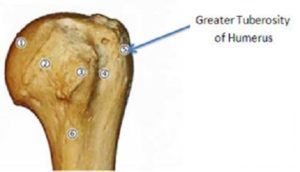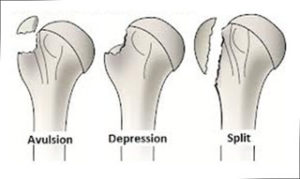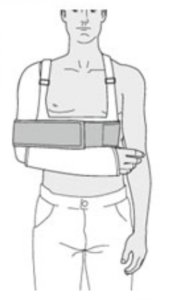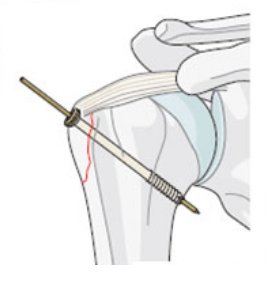Greater Tuberosity Fracture
The Greater Tubercle of the humerus is situated lateral to the head of the humerus and posterolateral to the lesser tubercle. Its upper surface is round and marked by three flat impressions.
- The highest of these gives ("superior facet") insertion to the Supraspinatus.
- The middle ("middle facet") to the Infraspinatus.
- The lowest one ("inferior facet"), and the body of the bone for about 2.5 cm. below it, to the Teres minor. The lateral surface of the Greater Tubercle is convex, rough, and continuous with the lateral surface of the body.

Fracture of Greater Tuberosity of Humerus : Isolated displaced greater tuberosity fractures are thought to occur in less than 2% of proximal humeral fractures.
The greater tuberosity fragments with its attached rotator cuff will characteristically have a longitudinal tear in the cuff between the supraspinatus and subscapularis tendons.
These fractures are often associated with anterior shoulder dislocation.
Types :
Isolated Greater Tuberosity Fractures are of three types

Treatment :
Most proximal humerus fractures will heal without surgery and many recover satisfactory function. Outcome of non-operative treatment depends upon the type of fracture, the degree of fragment displacement and intrinsic fracture stability.
Assessment of stability with image intensification is helpful. Without fixation, displaced proximal humerus fractures are rarely improved with closed fracture reduction.
Conservative Treatment:
Non-operative treatment should provide mechanical support until the patient is sufficiently comfortable to begin shoulder use and the fracture is sufficiently consolidated that displacement is unlikely.
Once these goals have been achieved, rehabilitative exercises can begin to restore range of motion, followed by strength and function. The three phases of non-operative treatment are
- Immobilization
- Passive / assisted range of motion
- Progressive resistance exercises
Duration of immobilization should be as short as possible and as long as necessary. Typically, immobilization is recommended for 2-3 weeks, followed by gentle range of motion exercises. Resistance exercises can be generally begun at 6 weeks. Isometric exercises may help maintaining strength during the first 6 weeks.
Indications for Surgery:
You may require surgery if you have any of the following :
- Presence of a mechanical block to reduction
- Post reduction displacement > 5 - 10 mm in any plane requires ORIF
- Note that 5 mm of displacement might end up causing impingement in younger patients
Surgical Options:
The Tuberosity Fragment is reduced and secured to its bed using heavy non absorbable sutures, either using a McGowan needle
or through drill holes
OR
Cancellous lag screws with washers may be used for achieving stable fixation.


